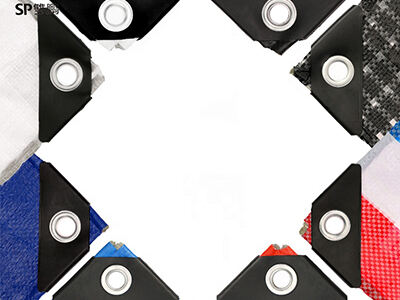Você precisa de uma lona impermeável para garantir que suas coisas fiquem secas e seguras quando está ao ar livre? Então, se você é novo nisso e quer saber que tipo de lona é bom para você, a quantidade de modelos e marcas pode ser esmagadora, especialmente se você não tiver muita experiência com esse tipo de coisa, porque uma lona pode ser realmente útil para muitas atividades. Este guia fornecerá insights sobre os diferentes materiais usados em lonas, descrevendo suas características para que você possa considerar quais opções podem atender melhor às suas necessidades.
Qual é o melhor material para lona impermeável?
Os dois plásticos mais comuns usados para fazer lonas são PE e PP, e ambos os tipos têm suas próprias vantagens e desvantagens, das quais é bom estar ciente.
Polietileno (PE) — plástico leve e flexível, fácil de carregar. O PE está ao nosso redor e é encontrado em objetos comuns como sacolas de compras e embalagens de alimentos. Quando o PE é usado para lonas, é econômico, o que significa que é barato. No entanto, embora o PE seja mais prático, não é tão durável quanto outros tipos e pode rasgar com mais facilidade ao longo do tempo, o que é especialmente verdadeiro se for usado frequentemente.
PP (Polipropileno): Plástico mais forte e rígido do que o PE. O PP é usado em tapetes, cordas e recipientes, então você pode encontrá-lo nesses produtos. As lonas de PP também são mais resistentes a condições adversas como calor ou carga pesada. Por outro lado, as lonas de PP geralmente são mais caras e não têm a mesma flexibilidade das lonas de PE, o que pode torná-las um pouco mais difíceis de usar.
Características Importantes das Lonas
Tenha isso em mente ao escolher uma lona, pois pode ser decisivo para ter uma boa lona adequada à sua profissão:
Impermeável: Uma lona bem-feita deve ser completamente lona pesada impermeável . Isso é especialmente importante se você estiver usando-o para cobrir itens que podem ser danificados pela chuva ou umidade.
Proteção UV: Se você pretende usar sua lona ao ar livre por períodos prolongados, ela deve ter algum nível de proteção UV contra os raios solares. Como o tempo pode enfraquecer o material pelo sol, seria muito mais fácil para a lona permanecer em boas condições com a ajuda dessa proteção contra UV.
Resistência a Lacerações e Perfurações: As lonas podem ser rasgadas por objetos afiados ou ventos fortes. A lona deve ser forte o suficiente para que cortes e buracos não se formem, assim ela poderá manter suas coisas seguras.
Costuras e Argolas: Examine como a lona está costurada. Verifique as bordas reforçadas e as argolas metálicas, ou gromets, que estão firmemente anexadas. Esses recursos podem manter a lona robusta e durável.
Leve em consideração o tamanho que você precisa para a lona. Ela deve se ajustar à área que você está tentando cobrir. Preste atenção ao peso também. Uma lona pesada pode ser difícil de transportar ou montar.
Por que Você Deve Se Importar com o Tarp Certo
Um lona impermeável tem muitos usos, incluindo:
Protegendo veículos, barcos ou máquinas do clima usando uma capa.
Protegendo móveis de jardim ou lenha da chuva e neve.
Tendas e mochilas como equipamentos de camping para se manter seco.
Construir um abrigo temporário quando você está ao ar livre (especialmente em um piquenique ou trilha).
Mantendo materiais de construção ou entulho, quando trabalhando em um projeto.
Dica do Oficial: Nem todas as lonas são iguais. Escolher a errada pode causar problemas. Uma capa muito pequena, por exemplo, pode deixar a chuva entrar e estragar suas coisas. Uma lona grande, no entanto, pode significar mais área de superfície para usar, mas também pode ser incômoda de mover e montar, tornando-a menos prática e difícil de usar.
Considere as seguintes perguntas antes de comprar uma lona para ajudá-lo a decidir a melhor opção para suas necessidades:
Onde usarei a lona, e que tipo de clima ela estará sujeita? Será em meio a ventos fortes ou chuvas torrenciais?
Por quanto tempo quero usar a lona? Com que frequência terei que substituí-la?
Quanto Devo Gastar com uma Lona? Qual é o meu orçamento?
Me importo em sacrificar alguns recursos por outros? Optaria por uma lona mais leve que pode não ser tão durável, ou uma mais pesada que o seja?
Comparando Lonas de PE e PP
Comparando lonas de PE e PP, aqui está o que você precisa considerar:
PE: Não é tão pesada quanto o PP, além de ser fácil de manejar e uma ótima opção para quem procura um transporte. Também é mais barata, o que é favorável para quem está atento ao orçamento. Mas tenha em mente que as lonas de PE podem rasgar com mais facilidade, especialmente com uso repetido ou se forem presas em objetos afiados.
PP: Este tipo de lona é comprimido e consegue suportar mais peso. Também é mais resistente à luz solar e pode suportar temperaturas mais altas. Se você planeja usar sua lona em climas quentes ou para atividades ao ar livre, isso pode ser muito importante. Mas as lonas de PP são mais caras e podem parecer mais pesadas, o que pode torná-las um pouco mais difíceis de manusear. E se forem expostas a temperaturas extremamente frias ou quentes por longos períodos, elas podem ficar britânicas e rachar.
Para resumir, os materiais PE e PP são bons para lona impermeável em diferentes graus. Selecionamos a melhor lona para suas necessidades conhecendo exatamente quais propriedades cada material possui. Assim, você pode aproveitar a proteção e a conveniência que uma boa lona pode oferecer para todo tipo de atividade ao ar livre divertida.

